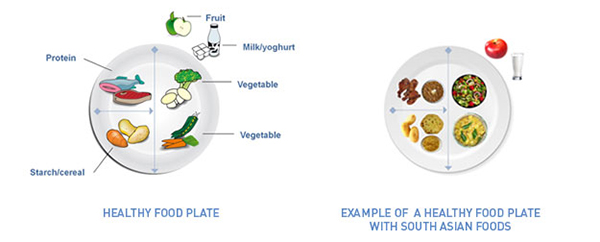|
• Diabetes Leader Editions |
|
• Educational Videos |
|
• Philippine Clinical Practice Guidelines for Diabetes |
|
• Article of the Month |
ARTICLE OF THE MONTH

|
Eat to Live or Live to Eat? (Basic healthy eating tips for people with diabetes) By: JOY ARABELLE C. FONTANILLA, MD, Let food be thy medicine |
There’s no such thing as a diabetic diet.
It may sound like heresy to some, but really, if you think about it, the general diet recommendations for people with diabetes apply to almost everyone. To be healthier, one should eat less sugar, saturated fat and salt while taking more fiber, vegetables, and whole grains.
Eating healthy is easier said than done. Unhealthy food choices like fast food and sugary drinks are just so much more accessible and convenient than healthy ones.
One easy way to learn to eat healthy is the plate method endorsed by organizations such as the International Diabetes Federation and the American Diabetes Association.

(Image source: http://www.idf.org/worlddiabetesday/toolkit/pwd/healthy-nutrition)
Here’s how to create a healthy food plate:
For lunch and dinner,
- Imagine a line across the middle of a nine-inch plate and another line from the left side to the middle creating 3 sections on your plate.
- Fill the largest section or half the plate with non-starchy vegetables like lettuce, eggplant, mushrooms, green beans, broccoli, carrots, cabbage, cauliflower, cucumber and spinach.
- In one of the smaller sections (1/4 of the plate), put the starchy foods like rice, noodles, corn, potatoes, oatmeal, and squash.
- On the other small section, put your protein such as fish, seafood, chicken, eggs, tofu, lean cuts of beef and pork.
- If your meal plan allows, add one serving of fruit (~1/2 cup) and/or dairy (e.g., low fat or skim milk, nonfat yogurt, soy milk).
- Choose small amounts of healthy fats as cooking oil, spreads or dressings like olive oil, nuts, seeds, avocados and trans fat free margarine.
- Add a low-calorie beverage like water, unsweetened tea or coffee to complete the meal.
For breakfast,
- Fill ¼ of your plate with starchy food.
- Fill ¼ of your plate with protein.
- Add one serving of fruit and/or dairy.
- Add a low-calorie drink.
Top Ten Tips
Here are some basic tips to help you and your loved ones make healthier food choices.
- Veggie up. Take lots of vegetables in a variety of colors to amp up the vitamins and antioxidants.
- Choose whole grains. Whole grain foods like brown rice, whole oats, quinoa and popcorn are preferred over white rice, white pasta, white or “wheat” bread, and french fries.
- Bean cuisine. Add beans like kidney or pinto and lentils in your menu. Beans are rich in antioxidants, fiber, protein, B vitamins, iron, magnesium, potassium, copper and zinc.
- Wish for fish. Eat fish at least twice a week. Oily fish like salmon, sardines and tuna are packed with healthy omega-3 fatty acids.
- Trim the fat. Take the skin off your poultry dishes like chicken or turkey. Prefer lean cuts of meat and remove any visible fat.
- Dairy dose. Choose low-fat dairy products like skim or 1% milk and yogurt.
- Drink right. Choose low-calorie beverages like water, unsweetened tea, and “diet” drinks over regular soft drinks, fruit punch and other sugary drinks.
- Oil over solids. Cook with liquid oils or sprays instead of solid fats. Choose healthier oils like olive, canola, corn and soybean.
- Snack well. Reduce snacking on calorie-loaded foods and desserts like chips, cookies, cakes, and full-fat ice cream. Some healthy snack ideas to choose from are: baby carrots, nuts, nonfat yogurt, whole wheat crackers, seeds, and soy chips.
- Portion control. Eating too much of any food, even healthy ones, can cause weight gain. Watch your portion sizes: ½ baseball = ½ cup; the size of a fist = 1 cup; a deck of cards = 3 oz meat; thumb = 1 tbsp; thumb tip = 1 tsp.
Diets, however, don’t come in a one-size-fits-all package.
For individualized meal plans, it would be ideal for one to consult a registered dietitian, particularly for those who may have special needs like mastery of carbohydrate counting for insulin dosing, portion control for weight management, food sensitivities, etc.
Food is as much a part of diabetes care as drugs and exercise. Learn to eat healthy and your food can help heal you.
